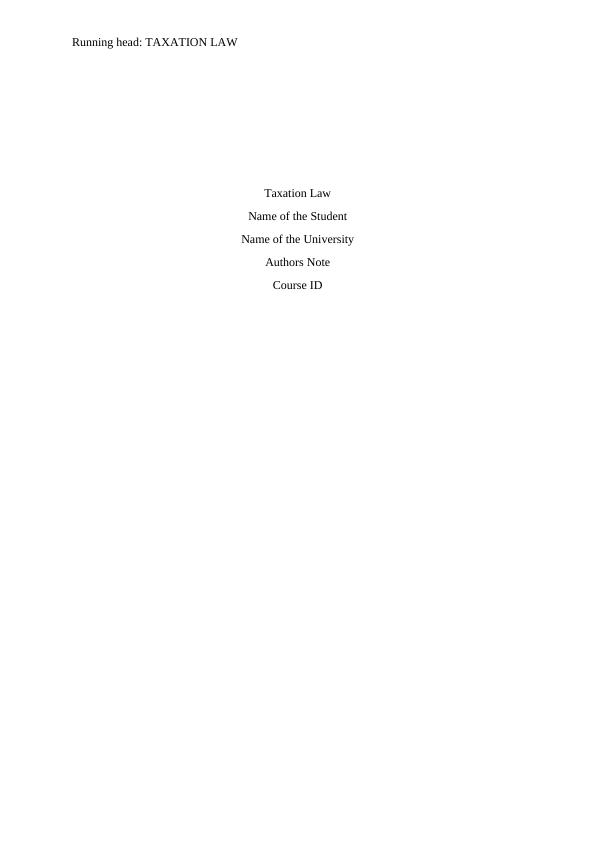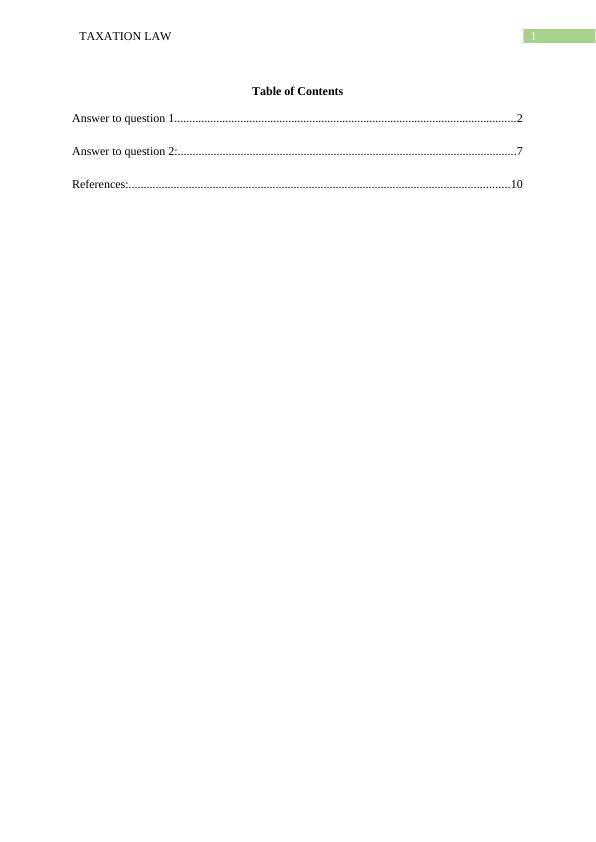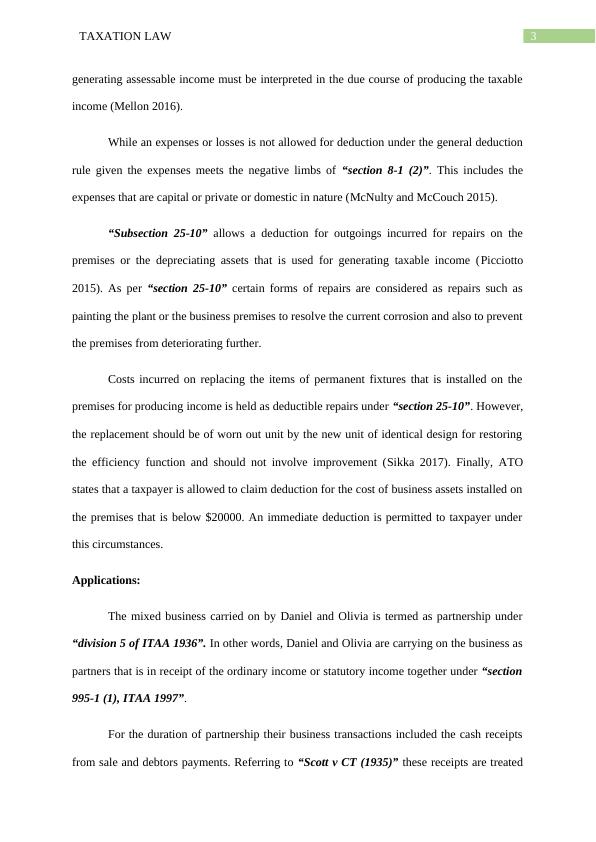Taxation Law: Partnership Net Income and Expense Payment Fringe Benefit
Added on 2023-04-24
12 Pages2661 Words103 Views
Running head: TAXATION LAW
Taxation Law
Name of the Student
Name of the University
Authors Note
Course ID
Taxation Law
Name of the Student
Name of the University
Authors Note
Course ID

1TAXATION LAW
Table of Contents
Answer to question 1..................................................................................................................2
Answer to question 2:.................................................................................................................7
References:...............................................................................................................................10
Table of Contents
Answer to question 1..................................................................................................................2
Answer to question 2:.................................................................................................................7
References:...............................................................................................................................10

2TAXATION LAW
Answer to question 1
Issues:
The issues involves establishing the net income of the partnerships under “division 5
of the Partnership Act 1936”.
Rule:
Denoting the explanation made in “division 5 of ITAA 1936” a partnership is not held
as the distinct entity under the general law and the partnership does not pays tax. Instead it is
the partners that pays tax on the distributed profits from the partnership (Lee 2015). The net
income of the partnership is determined under “section 90” as if the partners are Australian
resident. The definition of partnership refers to the carrying on the business as partners that is
in receipt of the ordinary income or statutory income together under “section 995-1 (1),
ITAA 1997”.
Importantly under “section 6-5, ITAA 1997” a receipt is not treated as the ordinary
income until and unless it meets certain perquisites (Mumford 2017). This includes that the
receipts should be cash or convertible into cash and it should be real gain to the taxpayer.
“Section 6-5 of ITAA 1997” defines ordinary income as the income in respect of the ordinary
concepts. As held in “Scott v CT (1935)” ordinary income is interpreted in accordance with
the ordinary concepts.
As a general rule “section 8-1” possess the potential of being implemented to any
taxpayer (Borden 2015). Under “section 8-1”, a loss or the expenses may be allowed for
income tax deduction if the outgoings are incurred in producing the taxable income or it is
necessarily occurred while carrying on the business for obtaining or producing the taxable
income. The court in “Amalgamated Zinc Ltd v FCT (1935)” held that the gaining or
Answer to question 1
Issues:
The issues involves establishing the net income of the partnerships under “division 5
of the Partnership Act 1936”.
Rule:
Denoting the explanation made in “division 5 of ITAA 1936” a partnership is not held
as the distinct entity under the general law and the partnership does not pays tax. Instead it is
the partners that pays tax on the distributed profits from the partnership (Lee 2015). The net
income of the partnership is determined under “section 90” as if the partners are Australian
resident. The definition of partnership refers to the carrying on the business as partners that is
in receipt of the ordinary income or statutory income together under “section 995-1 (1),
ITAA 1997”.
Importantly under “section 6-5, ITAA 1997” a receipt is not treated as the ordinary
income until and unless it meets certain perquisites (Mumford 2017). This includes that the
receipts should be cash or convertible into cash and it should be real gain to the taxpayer.
“Section 6-5 of ITAA 1997” defines ordinary income as the income in respect of the ordinary
concepts. As held in “Scott v CT (1935)” ordinary income is interpreted in accordance with
the ordinary concepts.
As a general rule “section 8-1” possess the potential of being implemented to any
taxpayer (Borden 2015). Under “section 8-1”, a loss or the expenses may be allowed for
income tax deduction if the outgoings are incurred in producing the taxable income or it is
necessarily occurred while carrying on the business for obtaining or producing the taxable
income. The court in “Amalgamated Zinc Ltd v FCT (1935)” held that the gaining or

3TAXATION LAW
generating assessable income must be interpreted in the due course of producing the taxable
income (Mellon 2016).
While an expenses or losses is not allowed for deduction under the general deduction
rule given the expenses meets the negative limbs of “section 8-1 (2)”. This includes the
expenses that are capital or private or domestic in nature (McNulty and McCouch 2015).
“Subsection 25-10” allows a deduction for outgoings incurred for repairs on the
premises or the depreciating assets that is used for generating taxable income (Picciotto
2015). As per “section 25-10” certain forms of repairs are considered as repairs such as
painting the plant or the business premises to resolve the current corrosion and also to prevent
the premises from deteriorating further.
Costs incurred on replacing the items of permanent fixtures that is installed on the
premises for producing income is held as deductible repairs under “section 25-10”. However,
the replacement should be of worn out unit by the new unit of identical design for restoring
the efficiency function and should not involve improvement (Sikka 2017). Finally, ATO
states that a taxpayer is allowed to claim deduction for the cost of business assets installed on
the premises that is below $20000. An immediate deduction is permitted to taxpayer under
this circumstances.
Applications:
The mixed business carried on by Daniel and Olivia is termed as partnership under
“division 5 of ITAA 1936”. In other words, Daniel and Olivia are carrying on the business as
partners that is in receipt of the ordinary income or statutory income together under “section
995-1 (1), ITAA 1997”.
For the duration of partnership their business transactions included the cash receipts
from sale and debtors payments. Referring to “Scott v CT (1935)” these receipts are treated
generating assessable income must be interpreted in the due course of producing the taxable
income (Mellon 2016).
While an expenses or losses is not allowed for deduction under the general deduction
rule given the expenses meets the negative limbs of “section 8-1 (2)”. This includes the
expenses that are capital or private or domestic in nature (McNulty and McCouch 2015).
“Subsection 25-10” allows a deduction for outgoings incurred for repairs on the
premises or the depreciating assets that is used for generating taxable income (Picciotto
2015). As per “section 25-10” certain forms of repairs are considered as repairs such as
painting the plant or the business premises to resolve the current corrosion and also to prevent
the premises from deteriorating further.
Costs incurred on replacing the items of permanent fixtures that is installed on the
premises for producing income is held as deductible repairs under “section 25-10”. However,
the replacement should be of worn out unit by the new unit of identical design for restoring
the efficiency function and should not involve improvement (Sikka 2017). Finally, ATO
states that a taxpayer is allowed to claim deduction for the cost of business assets installed on
the premises that is below $20000. An immediate deduction is permitted to taxpayer under
this circumstances.
Applications:
The mixed business carried on by Daniel and Olivia is termed as partnership under
“division 5 of ITAA 1936”. In other words, Daniel and Olivia are carrying on the business as
partners that is in receipt of the ordinary income or statutory income together under “section
995-1 (1), ITAA 1997”.
For the duration of partnership their business transactions included the cash receipts
from sale and debtors payments. Referring to “Scott v CT (1935)” these receipts are treated

End of preview
Want to access all the pages? Upload your documents or become a member.
Related Documents
Taxation Law: Determination of Net Income of Partnership and Fringe Benefit Taxlg...
|13
|2614
|270
Taxation Law: Partnership Net Income and Fringe Benefits Taxlg...
|12
|2589
|64
Taxation Law: Calculation of Net Income from Partnership and Fringe Benefit Taxationlg...
|13
|2590
|334
Taxation Lawlg...
|10
|2114
|297
TAXATION LAW Taxation Law Name of the University Authorslg...
|13
|2737
|310
Taxation Law Case Study: Determination of Partnership Net Income, Expenses, and Deductionslg...
|13
|2530
|341